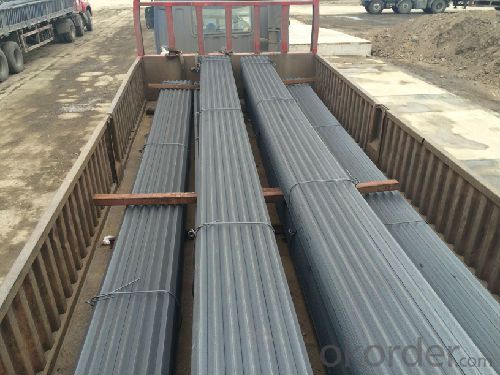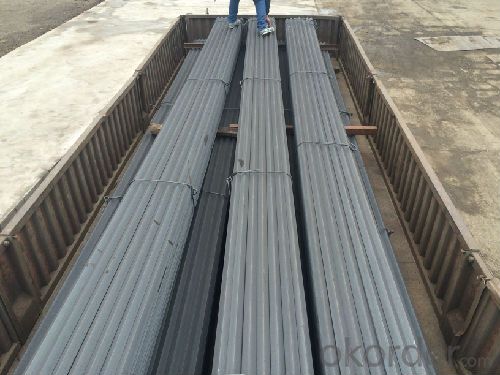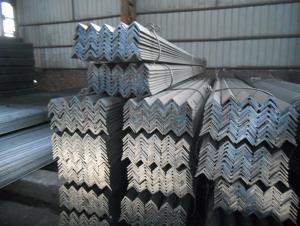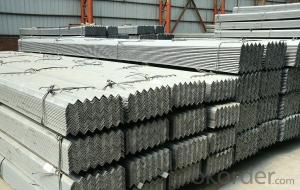Q345 angle, angle steel, galvanized angle steel
- Loading Port:
- Tianjin
- Payment Terms:
- TT or LC
- Min Order Qty:
- 25 m.t
- Supply Capability:
- 1000 m.t/month
OKorder Service Pledge
OKorder Financial Service
You Might Also Like
Item specifice
Product Description:
OKorder is offering Q345 angle, angle steel, galvanized angle steelat great prices with worldwide shipping. Our supplier is a world-class manufacturer of steel, with our products utilized the world over. OKorder annually supplies products to European, North American and Asian markets. We provide quotations within 24 hours of receiving an inquiry and guarantee competitive prices.
Product Applications:
Q345 angle, angle steel, galvanized angle steel are ideal for structural applications and are widely used in the construction of buildings and bridges, and the manufacturing, petrochemical, and transportation industries.
Product Advantages:
OKorder's Q235 Small angle, angle steel, galvanized angle steel are durable, strong, and resist corrosion.
Main Product Features:
· Premium quality
· Prompt delivery & seaworthy packing (30 days after receiving deposit)
· Corrosion resistance
· Can be recycled and reused
· Mill test certification
· Professional Service
· Competitive pricing
Product Description:
Angle called angle, the steel strip is perpendicular to each other on both sides into angular.Divided into equilateral angle steel and ranging from side angle. Two equilateral angle steel edge width is the same. The specification is expressed by edge width * width * thick edgenumber of millimeters. Such as "/ 30 x 30 x 3", namely that equilateral angle steel edge widthof 30 mm, 3 mm thick edge. Can also be used to model representation, model is the wideangle 3# cm, such as. The model does not represent the same type in different edge thickness size, thus in the contract and other documents on the angle of the edge width, edgethick size fill in complete, avoid alone represented by type. Hot rolled equilateral angle steelspecifications for 2#-20#. Angle according to the different needs of structure composed of a variety of stress components, can also be used as a component of the connections between the. Widely used in a variety of architectural and engineering structures, such as beams,bridges, towers, hoisting and conveying machinery, ships, industrial furnace, reactor,container frame and warehouse.
Mainly divided into equilateral angle steel, equilateral angle steel two categories, includingunequal angle can be divided into equal thickness and unequal thickness ranging from two.
Angle specifications with the side length of the size and edge thickness. At present, the domestic steel specifications for 2 - 20 cm in length, number of numbers, the same horn steel often have 2 - 7 different edge thickness. The actual size and inlet angle marked on both sides of the thickness and indicate the relevant standards. The general length of more than 312.5px for large angle steel, 312.5px - 125px for the medium angle, length of 125px for smallangle.
Inlet and outlet angle steel orders generally required the use specifications in the steel,carbon structural steel grades as appropriate. Is the angle in addition to standard number, nospecific composition and performance series.
Angle steel delivery length is divided into fixed length, size two, domestic steel length range is3 - 9m, 4 12M, 4 19m, 6 19m four range according to different specifications. Japanese steellength ranges from 6 to 15m.
Section of unequal angle height according to the long edge of the width to calculate the non equilateral angle steel. Refer to section angle and side length is not equal to the steel. Is a kind of angle steel. The length from 25mm * 16mm to 200mm * l25mm. By the hot rolling mill rolling in. General scalene angle steel specifications: thickness of 4-18mm / 50*32-- / 200*125
Equilateral angle steel is widely used in all kinds of metal structures, bridges, machinery manufacturing and shipbuilding industry, all kinds of architectural and engineering structures,such as beams, bridges, towers, hoisting and conveying machinery, ships, industrial furnace,reactor, container frame and warehouse etc.
FAQ:
Q1: Why buy Materials & Equipment from OKorder.com?
A1: All products offered byOKorder.com are carefully selected from China's most reliable manufacturing enterprises. Through its ISO certifications, OKorder.com adheres to the highest standards and a commitment to supply chain safety and customer satisfaction.
Q2: Can fit in the containers of 20fts the steel beams of 6M?
A2: No proble, we can put them into the containers in the form sideling.
Q3: The products are invoicing on theoritical weight or on actual weight?
A3: We can do it in both manners, according to the customers' request.
Images:


- Q:How are steel angles used in construction?
- Steel angles are commonly used in construction for a variety of purposes. One of the main uses of steel angles is to provide structural support and reinforcement in buildings and other structures. They are often used to create strong and stable connections between different components, such as beams, columns, and trusses. Steel angles are typically used to form the framework of a structure, providing stability and strength. They can be used to form corners, support beams, and brace walls. Steel angles are also frequently used to create lintels, which are horizontal supports placed above doors and windows to distribute the weight of the structure and prevent sagging. In addition to their structural uses, steel angles can also be used for aesthetic purposes in construction. They can be used to create decorative edging or trim, adding visual appeal to a building. Steel angles can also be used to create staircases, handrails, and other architectural features. Overall, steel angles are versatile and essential components in construction. They provide structural support, reinforcement, and aesthetic elements to ensure the durability, stability, and visual appeal of buildings and other structures.
- Q:What does "L125*8" stand for in steel structures?
- Equal angle steel, width 125, wall thickness 8
- Q:Are steel angles available in different finishes?
- Yes, steel angles are available in different finishes. Common finishes for steel angles include mill finish, hot-dip galvanized, powder-coated, and painted finishes.
- Q:Can steel angles be used in telecommunications towers?
- Yes, steel angles can be used in telecommunications towers. Steel angles are commonly used as structural components in the construction of telecommunications towers due to their strength, stability, and ability to withstand heavy loads. They provide the necessary support and stability required for the installation of antennas, equipment, and other telecommunications infrastructure.
- Q:What are the different test methods used to evaluate steel angles?
- There are several test methods used to evaluate steel angles in order to ensure their quality and suitability for various applications. These test methods include: 1. Tensile Test: This test measures the tensile strength, yield strength, and elongation properties of the steel angles. It involves applying a gradually increasing load to a specimen until it reaches its breaking point, allowing for assessment of the material's ability to resist forces without deforming or breaking. 2. Bend Test: The bend test evaluates the flexibility and ductility of steel angles. A specimen is bent to a specific angle and assessed for any signs of cracking, fracture, or deformation. This test is crucial in determining the angles' ability to withstand bending forces without compromising their structural integrity. 3. Charpy Impact Test: This test measures the impact resistance and toughness of steel angles by subjecting a notched specimen to a high-velocity impact. The amount of energy absorbed during the impact is measured, indicating the material's ability to resist sudden loads or shocks. 4. Hardness Test: The hardness test determines the steel angle's resistance to indentation or scratching. Different methods such as Rockwell, Brinell, or Vickers hardness tests may be employed to evaluate the material's hardness properties, which can help assess its durability and wear resistance. 5. Ultrasonic Testing: Ultrasonic testing uses high-frequency sound waves to detect flaws or defects within the steel angles. This non-destructive test method allows for the identification of internal cracks, voids, or inclusions that may affect the material's structural integrity. 6. Dimensional Inspection: This test method involves measuring the dimensions, tolerances, and geometric properties of the steel angles. It ensures that the angles meet the required specifications and can provide accurate information for engineering calculations and fabrication processes. By utilizing these various test methods, manufacturers, engineers, and quality control personnel can assess the mechanical properties, structural integrity, and overall quality of steel angles, ensuring their suitability for specific applications.
- Q:How do steel angles perform under dynamic or cyclic loading conditions?
- Steel angles have excellent performance under dynamic or cyclic loading conditions. Due to their high strength and stiffness, steel angles are able to withstand repeated loading and unloading without significant deformation or failure. Their structural integrity and resistance to fatigue make them suitable for various applications in industries such as construction, automotive, and aerospace.
- Q:What is the process of cold bending steel angles?
- The process of cold bending steel angles involves using hydraulic or mechanical forces to gradually shape the steel angle into a desired curve or angle without the use of heat. This is achieved by carefully manipulating and applying pressure to the steel angle until it is bent to the desired shape.
- Q:What are the safety precautions when working with steel angles?
- To minimize the risk of accidents and injuries when working with steel angles, it is crucial to follow specific safety measures. Here are some essential considerations: 1. Personal Protective Equipment (PPE) is essential. Make sure to wear safety glasses, gloves, steel-toed boots, and a hard hat to protect yourself from potential hazards like flying debris, sharp edges, and falling objects. 2. Proper handling is key. Utilize mechanical aids such as cranes or forklifts to lift and move heavy steel angles. Avoid manual lifting if the weight exceeds your capacity. Ensure secure stacking of angles and avoid overloading shelves or racks. 3. Organize and keep the work area clean to prevent accidents. Remove any obstructions or clutter that may hinder movement. Clearly mark areas where steel angles are stored or being worked on to prevent unauthorized access. 4. Regularly inspect and maintain tools and equipment used to work with steel angles. Repair or replace any defects promptly and avoid using damaged or faulty equipment. 5. When cutting or grinding steel angles, wear appropriate eye and face protection to shield against sparks, dust, and debris. Use tools specifically designed for cutting and grinding steel. Ensure proper ventilation in enclosed spaces to minimize the risk of inhaling toxic fumes. 6. Store steel angles in a designated area where they are secure and not at risk of falling or causing accidents. Use racks or shelves suitable for supporting the weight and size of the angles. Securely stack and strap them to prevent toppling over. 7. Implement proper fire safety measures. Steel angles can generate sparks when cut or welded. Have fire extinguishers and fire-resistant materials nearby. Keep flammable substances away from the work area. 8. Provide adequate training to all workers handling steel angles. Ensure they understand safety precautions, procedures, and emergency protocols. Encourage open communication and reporting of safety concerns or incidents. By following these safety precautions, you can create a safer working environment and minimize the risk of accidents when handling steel angles. Always prioritize your safety and the safety of others in your work with steel angles.
- Q:Can steel angles be used as supports for suspended acoustical ceilings?
- Yes, steel angles can be used as supports for suspended acoustical ceilings. Steel angles are often used as a main structural component in suspended ceiling systems. They provide stability and support for the acoustical ceiling tiles and help distribute the weight evenly across the ceiling grid. The steel angles are typically installed at regular intervals along the perimeter of the ceiling and are connected to the main suspension system. This ensures that the acoustical ceiling remains securely in place and can effectively absorb sound and improve the overall acoustics of the space.
- Q:What are the different connections used with steel angles?
- There are several different connections that can be used with steel angles, including bolted connections, welded connections, and clip connections. Bolted connections involve using bolts and nuts to connect the angles to other structural members. Welded connections involve fusing the angles to the other members using a welding process. Clip connections involve using clips or brackets to secure the angles to the other members. The choice of connection depends on factors such as the load requirements, design specifications, and fabrication capabilities.
1. Manufacturer Overview |
|
|---|---|
| Location | |
| Year Established | |
| Annual Output Value | |
| Main Markets | |
| Company Certifications | |
2. Manufacturer Certificates |
|
|---|---|
| a) Certification Name | |
| Range | |
| Reference | |
| Validity Period | |
3. Manufacturer Capability |
|
|---|---|
| a)Trade Capacity | |
| Nearest Port | |
| Export Percentage | |
| No.of Employees in Trade Department | |
| Language Spoken: | |
| b)Factory Information | |
| Factory Size: | |
| No. of Production Lines | |
| Contract Manufacturing | |
| Product Price Range | |
Send your message to us
Q345 angle, angle steel, galvanized angle steel
- Loading Port:
- Tianjin
- Payment Terms:
- TT or LC
- Min Order Qty:
- 25 m.t
- Supply Capability:
- 1000 m.t/month
OKorder Service Pledge
OKorder Financial Service
Similar products
New products
Hot products
Hot Searches
Related keywords





























